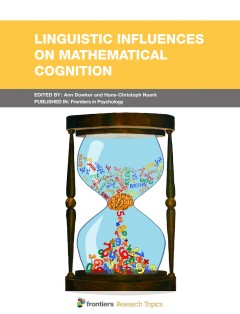Filter by

Origins of human language: continuities and discontinuities with nonhuman pri…
This book proposes a detailed picture of the continuities and ruptures between communication in primates and language in humans. It explores a diversity of perspectives on the origins of language, including a fine description of vocal communication in animals, mainly in monkeys and apes, but also in birds, the study of vocal tract anatomy and cortical control of the vocal productions in monkeys…
- Edition
- -
- ISBN/ISSN
- 9783631737262 (hardcover)
- Collation
- 365 pages ; 22 cm.
- Series Title
- Speech production and perception ; vol. 4
- Call Number
- 401 ORI o

Semantic systems. The power of AI and knowledge graphs
This open access book constitutes the refereed proceedings of the 15th International Conference on Semantic Systems, SEMANTiCS 2019, held in Karlsruhe, Germany, in September 2019. The 20 full papers and 8 short papers presented in this volume were carefully reviewed and selected from 88 submissions. They cover topics such as: web semantics and linked (open) data; machine learning and deep learn…
- Edition
- -
- ISBN/ISSN
- 9783030332204
- Collation
- 392 p.; 23 cm.
- Series Title
- 15th International Conference, SEMANTiCS 2019, Karlsruhe, Germany, September 9–12, 2019, Proceedings
- Call Number
- 401.43 SEM s

Communication and discourse theory : collected works of the brussels discours…
The introduction to the edited volume Communication and Discourse Theory aims to reflect on the interaction between discourse theory and the study of media and communication, as well as the Brussels Discourse Theory Group’s contribution to it. The chapter starts with a summary of the main tenets of Laclau and Mouffe’s discourse theory, and touches upon its methodological/analytical translat…
- Edition
- -
- ISBN/ISSN
- 9781789380569
- Collation
- 318 p.; 23 cm.
- Series Title
- -
- Call Number
- 401.43 COM c

Language, cognition and gender
Gender inequality remains an issue of high relevance, and controversy, in society. Previous research shows that language contributes to gender inequality in various ways: Gender-related information is transmitted through formal and semantic features of language, such as the grammatical category of gender, through gender-related connotations of role names (e.g., manager, secretary), and through …
- Edition
- -
- ISBN/ISSN
- 9782889198924
- Collation
- 188 p.; 23 cm.
- Series Title
- -
- Call Number
- 410.15195 GAR l

Linguistic influences on mathematical cognition
For many years, an abstract, amodal semantic magnitude representation, largely independent of verbal linguistic representations, has been viewed as the core numerical or mathematical representation This assumption has been substantially challenged in recent years. Linguistic properties affect not only verbal representations of numbers, but also numerical magnitude representation, spatial magnit…
- Edition
- -
- ISBN/ISSN
- 9782889452002
- Collation
- 173 p.; 23 cm.
- Series Title
- -
- Call Number
- 410.15195 HAN l

Syntax of Dutch: adjectives and adjective phrases
The Syntax of Dutch will be published in at least seven volumes in the period 2012-2016 and aims at presenting a synthesis of the currently available syntactic knowledge of Dutch. It is primarily concerned with language description and not with linguistic theory, and provides support to all researchers interested in matters relating to the syntax of Dutch, including advanced students of languag…
- Edition
- -
- ISBN/ISSN
- 9789089645494
- Collation
- -
- Series Title
- Comprehensive Grammar Resources, 3
- Call Number
- 439.315 BRO s

The Alor-Pantar languages: history and typology. Second edition.
The Alor-Pantar family constitutes the westernmost outlier group of Papuan (Non-Austronesian) languages. Its twenty or so languages are spoken on the islands of Alor and Pantar, located just north of Timor, in eastern Indonesia. Together with the Papuan languages of Timor, they make up the Timor-Alor-Pantar family. The languages average 5,000 speakers and are under pressure from the local Mala…
- Edition
- 2nd Edition
- ISBN/ISSN
- 9783961100224
- Collation
- 509 p.; 23 cm.
- Series Title
- -
- Call Number
- 499.12 KLA a

Form and formalism in linguistics
"Form" and "formalism" are a pair of highly productive and polysemous terms that occupy a central place in much linguistic scholarship. Diverse notions of "form" – embedded in biological, cognitive and aesthetic discourses – have been employed in accounts of language structure and relationship, while "formalism" harbours a family of senses referring to particular approaches to the study of …
- Edition
- -
- ISBN/ISSN
- 9783961101832
- Collation
- -
- Series Title
- -
- Call Number
- 425 MCE f

Interdisciplinary approaches to semiotics
This volume stresses the contemporary relevance of semiotics. The introductory chapter shows how the collection of papers emphasises crossings at the material level of physical reality as well as in their semio-cognitive and cultural implications, questioning the delimitation of interdisciplinary borders between the social sciences and humanities and STEM disciplines. The volume shows how semio…
- Edition
- -
- ISBN/ISSN
- 9789535146988
- Collation
- 222 p.; 23 cm.
- Series Title
- -
- Call Number
- 401.41 INT i

Accessing conceptual representations for speaking
For speaking, words in the lexicon are somehow activated from conceptual representations but we know surprisingly little about how this works precisely. Which of the attributes of the concept DOG (e.g. BARKS, IS WALKED WITH A LEASH, CARNIVORE, ANIMATE) have to be activated in a given situation to be able to select the word ‘dog’? Are there things we know about dogs that are always activated…
- Edition
- -
- ISBN/ISSN
- 9782889450114
- Collation
- 141 p.; 23 cm.
- Series Title
- -
- Call Number
- 418 IND a
 Computer Science, Information & General Works
Computer Science, Information & General Works  Philosophy & Psychology
Philosophy & Psychology  Religion
Religion  Social Sciences
Social Sciences  Language
Language  Pure Science
Pure Science  Applied Sciences
Applied Sciences  Art & Recreation
Art & Recreation  Literature
Literature  History & Geography
History & Geography